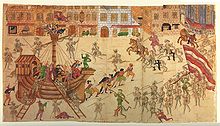
Back Lestr ar Folled BR Loď bláznů Czech ספינת השוטים (משל) HE Brod luđaka Croatian Dárafley IS Navis stultorum LA Schip der dwazen Dutch Narrenes skip NB Statek głupców Polish Nau dos insensatos Portuguese

The ship of fools (Modern German: Das Narrenschiff, Latin: Stultifera Navis), is an allegory, first appearing in Book VI of Plato's Republic, about a ship with a dysfunctional crew. The allegory is intended to represent the problems of governance prevailing in a political system not based on expert knowledge.
Images of the ship became popular, especially in German-speaking lands, especially after the publication of Sebastian Brant's satirical book Ship of Fools (1494), which served as the inspiration for Hieronymus Bosch's painting, Ship of Fools. Normally, the images show a ship crowded with men mostly wearing traditional jester or fool's costume with cloth ears ending in bells, many quarreling, drinking, and fighting. In the book a ship—an entire fleet at first—sets off from Basel, bound for the Paradise of Fools. In it, Brant conceives Saint Grobian, whom he imagines to be the patron saint of vulgar and coarse people. In literary and artistic compositions of the 15th and 16th centuries, the cultural motif of the ship of fools also served to parody the "ark of salvation", as the Catholic Church was styled.[citation needed]

A "complex political satire", whose composition was repeated in at least seven different 15th-century prints, indicating great popularity, shows Pope Paul II and the Holy Roman Emperor Frederick III wrestling at the top of a ship's mast, wearing only briefs and their respective Papal tiara and crown. Emblems and labels cover many other European powers; the allegory is of the political fall-out from meetings between the two men in 1468-69.[1]
After the Protestant Reformation, some depictions took a sectarian turn. A woodcut illustration to an edition of 1584 of Brant's book shows the Anti-Christ sitting on top of the overturned Narrenschiff, while in the foreground Saint Peter guides a small boat of respectably-dressed men safely to shore.[2]
"Ship of Fools" has continued to be used into the 20th century as the title for numerous books, songs and other works. Some German cities have modern public sculptures of the subject: a fountain by Jürgen Weber in Nuremberg (1980s), a sculptural group in Neuenburg am Rhein (2004), a fountain in Cologne, and one in Bräunlingen of the shipwrecked boat.

- ^ Jay A. Levinson (ed.) Early Italian Engravings from the National Gallery of Art, National Gallery of Art, Washington (Catalogue), 1973, pp. 162-164 (162 quoted), LOC 7379624; Mark McDonald, Ferdinand Columbus, Renaissance Collector, p. 100, 2005, British Museum Press,ISBN 978-0-7141-2644-9
- ^ Library of Congress